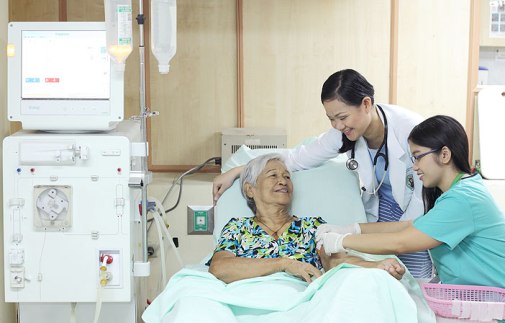
The Philippines is the 13th most populous country with a population of over 109 million people spread across 7,000 islands. Since the 1970s, the Philippines has mostly seen improvement to their healthcare system. There has been a steady decline in infant mortality rates and a slow increase in life expectancy. Despite many reforms, issues like childhood pneumonia, high rate of TB cases and a high maternal mortality rate remain. Health is a basic human right guaranteed by the Philippine Constitution of 1987. The Philippine health system is a dual health system composed of the public and private sectors. Health services in the public sector are provided by health facilities run by the government and are largely financed through a tax-based budgeting system. The private sector is mostly market-oriented, where health services are generally paid for through user fees at the point of service.
One of the first major reforms occurred in 1991 when the Local Government Code was passed. It devolved primary and secondary health services delivery from the Department of Health (DoH) to local government units (LGUs). Under this devolution, health care providers were divided along municipal, provincial and regional lines. LGUs were then responsible for the provision of health care in their regions as well as the management of public clinics and hospitals. The National Health Insurance Act of 1995 established PhilHealth, which is managed by the Philippine Health Insurance Corporation (PHIC). A 2010 reform effort aimed at achieving universal coverage by increasing the enrolment of poor families in PhilHealth, offer a more comprehensive benefits package and reduce or eliminate co-payments. In 2014, the Republic Act 10645 was signed, which granted automatic coverage of the full range of PhilHealth benefits to F citizens 60 and over, with the national government paying their premiums.
Filipino President Rodrigo Duterte signed the Universal Healthcare Bill (UHB) into law in 2019. The new law guarantees that all Filipinos have access to affordable healthcare. The UHB is a significant expansion of PhilHealth. Anybody who was not previously enrolled can now benefit. There are just two categories, one for those that are able to pay premiums, those who are employed, and one for those unable to pay premiums like the unemployed and the elderly. In these cases, the government will sponsor their coverage. People in both groups receive the same basic benefits. Those paying higher premiums will be eligible for more benefits. Healthcare in the Philippines remains predominantly prescriptive rather than preventative and the UHB hopes to change that.

Despite programs like PhilHealth out-of-pocket costs remain high. Though the UHB will help lower them for the poorest of the population. Traditionally, one of the highest out-of-pocket costs in the Philippines has been medication. To help combat this the government passed a few reforms making generic medications the only option. Government spending on healthcare has increased since the UHB. The private healthcare system is similar to that in the U.S. Filipinos who can afford private health facilities usually choose these as their main option. Private facilities provide a better quality of care than the public ones that lower income families usually go to. The public facilities tend to be in rural areas that are more run down. These facilities have fewer medical staff and inferior supplies. Only 30% of health professionals are employed by the government to address the health needs of the majority. Healthcare in the Philippines suffers because the remaining 70% of health professionals work in the more expensive privately run sectors.
Even with all the progress made in the last couple of decades problems still persist. The quality of healthcare in the Philippines varies widely between urban and rural areas. The standard of public healthcare varies directly alongside the average income in the area. Urban areas tend to have a higher average income than in rural areas. The urban areas receive excellent equipment and staff, while services in rural areas are not provided the same quality. Though the doctors are of the same quality in public hospitals, private facilities are better equipped and treatment is more easily obtained. One reason for this division is the number of people who rely on public healthcare in the Philippines. There is the issue of Filipino medical staff moving to countries with better pay and facilities. The Philippines is the biggest supplier for medical personnel in the world.
